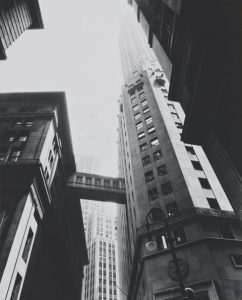
![]() In 1939, Berenice Abbott published Changing New York, her monumental survey of the material culture and built environment of New York. Funded by the Depression Era’s Federal Art Project, Abbot’s photographs examined old buildings that were slated to be demolished, as well as new construction. Inspired by French photographer Eugène Atget’s earlier chronicle of the streets of Paris, Abbott applied her awareness of modernist aesthetics, especially Surrealism, to her work. Using a large format 8x 10 Century Universal camera, she produced a detailed record of the city.
In 1939, Berenice Abbott published Changing New York, her monumental survey of the material culture and built environment of New York. Funded by the Depression Era’s Federal Art Project, Abbot’s photographs examined old buildings that were slated to be demolished, as well as new construction. Inspired by French photographer Eugène Atget’s earlier chronicle of the streets of Paris, Abbott applied her awareness of modernist aesthetics, especially Surrealism, to her work. Using a large format 8x 10 Century Universal camera, she produced a detailed record of the city.
The Wall and Hanover Building at 63 Wall Street provides a backdrop for the Farmer’s Trust Building at 22 William Street on the right and the National City Bank at 55 Wall Street on the left, as well as the pedestrian bridge that connects them. The unusual viewpoint and unexpected enclosed bridge between the buildings in this photograph underscore the geometries of urban canyons and modern skyscrapers. Unlike Edward Steichen’s view of the Flatiron Building from two decades earlier, with its trees and evening atmosphere, this photograph concentrates solely on the urban built environment.
As art historian Peter Barr has noted, Abbott’s attitude about the city was deeply influenced by Lewis Mumford’s writings about America, especially his division of American history into technological eras. Like Mumford, Abbott descried the industrial effects of the post-Civil War “paleotechnic era” and hoped that urban planning would bring about a more humane and human-scaled “neotechnic era.”[footnote]Peter Barr, Becoming Documentary: Berenice Abbott’s Photographs 1925-1939. Ph.D. Dissertation, Boston University.[/footnote]